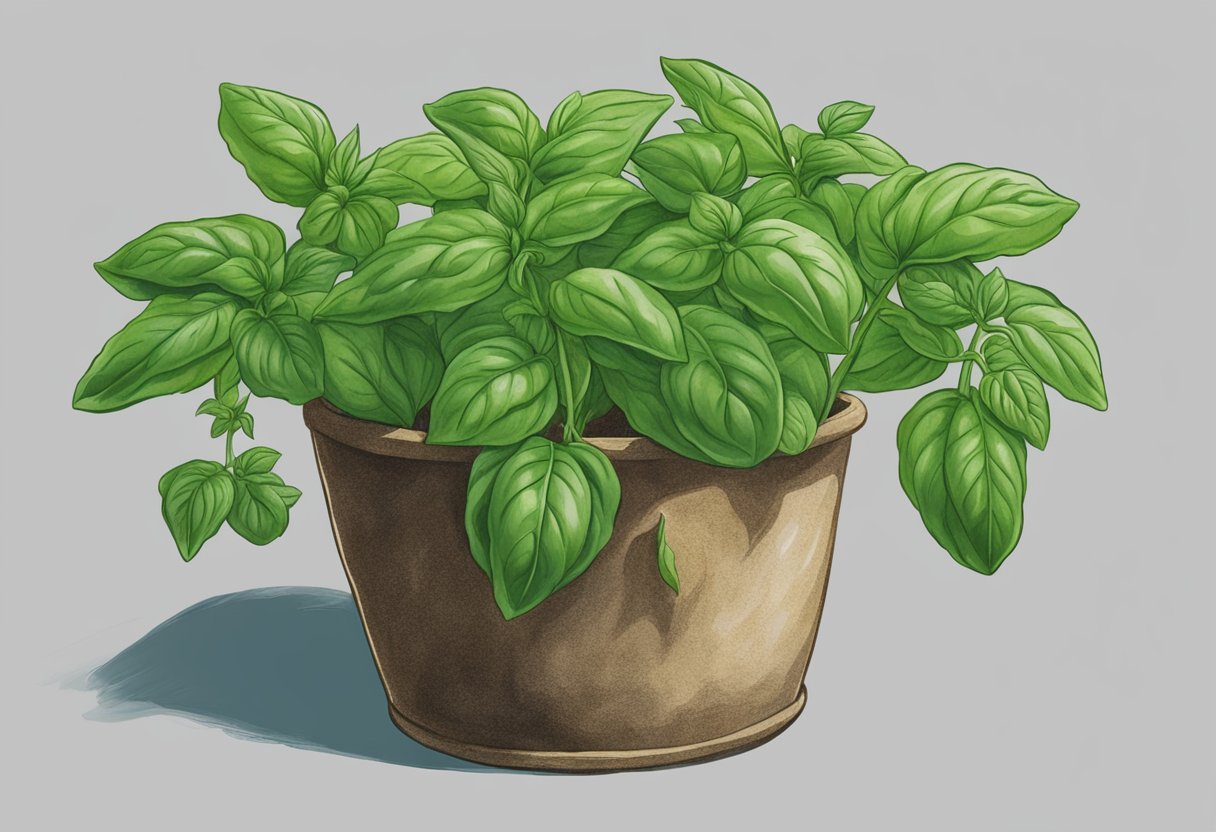Basil, with its aromatic leaves and reputation for being easy to grow, is a staple in many herb gardens. However, when this normally hearty plant begins to droop, it can leave gardeners feeling perplexed and concerned. From my experience, wilting basil isn’t just an aesthetic issue; it can signal underlying problems ranging from water stress to serious infections.

My basil plants have thrived when I have quickly addressed the drooping issues, which typically involve environmental factors or disease.
The causes of droopy basil plants are varied, but they typically include watering issues, fungal diseases such as Fusarium wilt and Leaf Spot, or even pests. My approach is to start by examining the watering schedule, ensuring the plant isn’t either waterlogged or parched. I then look for symptoms of disease or pest infestations, identifying any brown spots, yellow leaves, or the presence of insects. Addressing the root cause has always been key to reviving my aromatic plants.
JUMP TO TOPIC
Cultivating a Robust Basil Plant
To ensure your basil thrives, pay careful attention to soil quality, lighting conditions, and watering practices. Mastering these fundamentals promotes a strong, healthy plant.
Choosing the Right Soil and Sunlight
I choose well-drained soil rich in organic matter for my basil plants. They thrive in a location that offers 6 to 8 hours of direct sunlight daily. Both factors are crucial; well-drained soil prevents water accumulation, which can lead to root rot, and adequate sunlight supports vigorous growth and essential oil production in the leaves.
Watering Essentials for Basil Health
My basil watering schedule is regular yet moderate, ensuring that the soil’s top inch is dry before I water again. Overwatering can be just as harmful as underwatering, leading to limp, droopy leaves. In pots, proper drainage holes are essential to avoid root rot.
Transplanting Techniques
I carefully transplant my basil to avoid shock, which can cause drooping. I ensure the new location mirrors the conditions of its previous one, as sudden changes in sunlight, temperature, or wind can stress the plant. Acclimatizing the basil gradually over several days and providing ample water post-transplant can help prevent transplant shock. For potted basil plants, selecting a pot that accommodates future growth with adequate room for roots is key.
Dealing With Basil Plant Challenges
Basil plants, a favorite in the herb garden, can become droopy or wilted due to various challenges. My emphasis on proper care and environmental control can mitigate these issues effectively.
Combating Pests and Fungal Issues
Fungal diseases such as fusarium wilt and root rot can leave basil foliage looking lifeless. These are often water-borne diseases, making drainage and proper watering crucial. Pests like aphids and spider mites also threaten basil plants by extracting vital fluids from the leaves, leading to a droopy appearance.
To handle these pests, I apply insecticidal soap, ensuring to cover all areas of the plant for maximum effect.
In combating fungal issues, I strive for preventive measures first, which include selecting disease-resistant varieties and providing adequate air circulation. When fungal disease is present, infected leaves should be removed immediately, and fungicide may be applied if necessary.
Preventing and Addressing Diseases
My preventative measures against diseases include proper watering techniques. I ensure the soil is moist but not waterlogged, and I let it dry slightly between waterings to prevent root rot. Stress and shock from overwatering or underwatering can lead to droopiness, so I maintain a consistent watering routine.
Basil plants appreciate well-draining soil and pots with drainage holes to fend off water-borne diseases like downy mildew.
If I notice the early symptoms of disease, such as unusual spotting on the leaves, I take immediate steps to address them. For instance, with root rot, I may need to repot the plant into fresh soil and ensure that future watering is done more cautiously.
Enhancing Basil Growth and Flavor
To promote a flourishing basil plant with optimal flavor, attention to proper pruning techniques and growing conditions is essential.
Pruning and Harvesting Techniques
I make sure to regularly prune basil by pinching off the tips, which encourages bushier growth and prevents early flowering. Once basil flowers, the leaves can lose some of their flavors. When I harvest, I pick leaves from the top down, making sure to cut right above a leaf pair. This stimulates the plant to grow two new stems.
- Pinch the tips to promote bushiness.
- Avoid letting the plant go to seed.
- Harvest regularly to stimulate growth.
Optimizing Growing Conditions
My basil thrives in a location with full sun; however, during the hottest part of the day, a little shade can prevent wilting. I ensure the plant has good air circulation to minimize disease risk. If temperatures begin to drop, I sometimes use mulch to help stabilize the root temperature. Sudden temperature changes are stressful for basil, so I try to protect my plants from this as much as possible.
Basil loves full sun, well-drained soil, regular watering, and good air circulation. Protection from extreme temperature changes will keep it healthy and vibrant.












